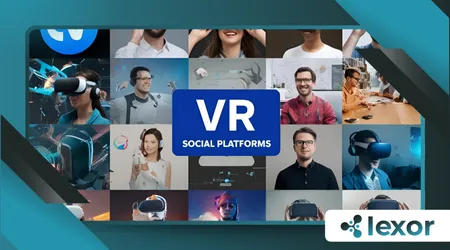VR Social Platforms: The Next Generation of Digital Connection

In 2025, VR social platforms are no longer a futuristic concept—they are a reality reshaping how we connect, communicate, and collaborate.
These immersive digital spaces are redefining human interaction, offering experiences that go beyond the limitations of traditional social media.
From virtual concerts to global meetups, VR social platforms are creating a new era of digital connection that feels more authentic, engaging, and meaningful.
The rise of these platforms comes at a time when traditional social media is facing significant challenges.
Users are increasingly fatigued by endless scrolling, algorithmic feeds, and the superficiality of likes and comments.
In contrast, VR social platforms provide a sense of presence and immersion that fosters deeper connections.
According to a 2024 study by Statista, 42% of VR users reported feeling more emotionally connected to others in virtual environments compared to traditional video calls.
This statistic underscores the transformative potential of VR as a tool for human connection.
But what exactly makes VR social platforms so compelling? And how are they poised to become the next frontier of digital interaction? Let’s dive deeper into this exciting evolution.
The Rise of Immersive Social Spaces
The concept of socializing in virtual environments isn’t entirely new. Platforms like Second Life paved the way over a decade ago, but the technology of the time limited their potential.
Fast forward to 2025, and VR social platforms have evolved into fully immersive, interactive spaces where users can engage in real-time activities with a sense of presence that feels almost tangible.
Imagine attending a live concert in VR, where you can see your favorite artist perform on a virtual stage, interact with other fans, and even feel the vibrations of the music through haptic feedback.
Or picture collaborating with colleagues in a virtual office, where you can brainstorm ideas on a digital whiteboard, share documents, and communicate as if you were in the same room.
These experiences are no longer science fiction—they are happening right now on platforms like Horizon Worlds, VRChat, and AltspaceVR.
What sets VR social platforms apart is their ability to create shared experiences that feel real.
Unlike traditional video calls or text-based interactions, VR allows users to read body language, make eye contact, and engage in activities together.
This level of immersion fosters a sense of connection that is difficult to achieve through other digital mediums.
+ Virtual Museums: Exploring Art Through VR Technology
Breaking Down Barriers

One of the most transformative aspects of VR social platforms is their ability to break down geographical and physical barriers.
In a world where distance often limits our ability to connect, VR offers a solution that feels both practical and magical.
For example, consider a family spread across different continents. With VR, they can gather in a virtual living room, play games, share stories, and celebrate milestones as if they were physically together.
Similarly, professionals can attend international conferences without the need for travel, reducing costs and environmental impact while maintaining the benefits of face-to-face interaction.
This accessibility is particularly impactful in fields like education and healthcare.
Students in remote areas can attend virtual classrooms with peers from around the world, while doctors can conduct consultations and even perform virtual surgeries using VR technology.
The possibilities are endless, and the implications for global connectivity are profound.
Also Read: VR Fitness: The Future of Home Workouts
The Role of Avatars and Identity
At the heart of every VR social platform is the avatar—a digital representation of the user that serves as their identity in the virtual world.
Avatars are more than just visual stand-ins; they are tools for self-expression and creativity.
Users can customize their avatars to reflect their real-life appearance or create entirely new personas.
This flexibility allows individuals to explore different aspects of their identity, experiment with self-presentation, and connect with others in ways that feel authentic and empowering.
For instance, someone who is shy in real life might feel more confident expressing themselves through a bold, outgoing avatar.
Similarly, individuals with disabilities can use avatars to navigate virtual spaces without the physical limitations they might face in the real world.
This inclusivity is one of the most powerful aspects of VR social platforms, making them a welcoming space for diverse communities.
+ DeFi Guide: Understanding Decentralized Finance in 2025
Challenges and Opportunities
While the potential of VR social platforms is immense, they are not without challenges. One of the most significant barriers to widespread adoption is accessibility.
High-quality VR equipment can be expensive, and not everyone has the resources to invest in the necessary hardware.
However, advancements in technology are driving costs down, making VR more accessible to a broader audience.
Standalone headsets like the Meta Quest 3 and affordable alternatives from companies like Pico are helping to democratize access to VR.
Additionally, cloud-based solutions are emerging, allowing users to experience VR without the need for powerful local hardware.
Another challenge is ensuring user safety and privacy. As with any online platform, VR social spaces are vulnerable to issues like harassment, data breaches, and inappropriate content.
Developers must prioritize robust security measures, including AI-driven moderation tools, user reporting systems, and clear community guidelines.
Despite these challenges, the opportunities far outweigh the risks.
VR social platforms have the potential to revolutionize industries, create new forms of entertainment, and bring people closer together in ways that were previously unimaginable.
Practical Applications of VR Social Platforms
The versatility of VR social platforms is evident in their wide range of applications. Here are a few examples of how these platforms are being used in 2025:
- Education: Virtual classrooms are becoming increasingly popular, offering students immersive learning experiences that go beyond traditional lectures. For example, history students can explore ancient civilizations in VR, while medical students can practice surgeries in a risk-free environment.
- Remote Work: Companies are using VR platforms to create virtual offices where employees can collaborate in real-time. These spaces often include features like digital whiteboards, file-sharing systems, and breakout rooms for team discussions.
- Entertainment: From virtual concerts to interactive gaming experiences, VR social platforms are redefining entertainment. Artists like Travis Scott and Billie Eilish have already hosted virtual concerts, attracting millions of attendees from around the world.
- Healthcare: VR is being used for everything from virtual therapy sessions to remote surgeries. Patients can consult with doctors in virtual clinics, while medical professionals can practice complex procedures in a simulated environment.
Table 1: Key Features of Leading VR Social Platforms (2025)
| Platform | Key Features | Unique Selling Point |
|---|---|---|
| Horizon Worlds | Customizable environments, live events | Meta’s ecosystem integration |
| VRChat | User-generated content, diverse avatar options | Strong community-driven focus |
| AltspaceVR | Professional networking, virtual conferences | Microsoft-backed enterprise solutions |
| Rec Room | Gaming-centric, cross-platform compatibility | Family-friendly and accessible |
Table 2: User Demographics on VR Social Platforms (2024)
| Age Group | Percentage of Users | Primary Use Case |
|---|---|---|
| 18-24 | 35% | Socializing, gaming, and entertainment |
| 25-34 | 40% | Remote work, networking, and education |
| 35-44 | 18% | Professional collaboration, virtual events |
| 45+ | 7% | Healthcare, virtual travel, and hobbies |
The Future of Digital Connection
As we look to the future, it’s clear that VR social platforms are more than just a technological trend—they are a fundamental shift in how we connect.
With advancements in AI, haptic feedback, and augmented reality (AR), these platforms will only become more immersive and interactive.
Imagine a world where you can feel a handshake in VR, or where AI-driven avatars can mimic your facial expressions in real-time.
These innovations are already in development, and they promise to make virtual interactions feel even more lifelike and meaningful.
However, the success of VR social platforms will depend on their ability to balance innovation with inclusivity.
Developers must ensure that these spaces remain accessible, safe, and welcoming for all users, regardless of their background or resources.
A New Era of Connection
In conclusion, VR social platforms represent the next generation of digital connection, offering experiences that are immersive, interactive, and deeply human.
They have the potential to transform how we socialize, work, learn, and entertain ourselves, breaking down barriers and creating opportunities for meaningful interaction.
As we continue to navigate the complexities of the digital age, these platforms remind us that technology, when used thoughtfully, can enhance rather than replace human connection.
The future of social interaction is here, and it’s virtual, vibrant, and full of possibilities.
Frequently Asked Questions (FAQs)
1. What are VR social platforms?
VR social platforms are immersive digital spaces where users can interact with others in real-time using virtual reality technology.
These platforms allow for activities like socializing, gaming, attending events, and collaborating in virtual environments.
2. Do I need expensive equipment to use VR social platforms?
While high-end VR headsets offer the best experience, there are now more affordable options available, such as standalone headsets like the Meta Quest 3.
Additionally, cloud-based solutions are emerging, reducing the need for powerful local hardware.
3. Are VR social platforms safe?
Safety is a priority for developers. Most platforms include features like AI moderation, user reporting systems, and clear community guidelines to ensure a safe and welcoming environment.
However, users should always be cautious and follow best practices for online safety.
4. Can I use VR social platforms for work?
Absolutely! Many professionals use VR platforms for remote work, virtual meetings, and collaborative projects.
Features like digital whiteboards and file-sharing systems make these platforms ideal for teamwork.
5. How do avatars work in VR social platforms?
Avatars are customizable digital representations of users. They can be designed to look like the user or take on entirely new forms, allowing for creative self-expression and inclusivity.
6. What industries are benefiting from VR social platforms?
Industries like education, healthcare, entertainment, and remote work are leveraging VR social platforms for immersive learning, virtual consultations, live events, and collaborative workspaces.
7. Can I attend live events on VR social platforms?
Yes! Many platforms host live events, including concerts, conferences, and meetups. These events offer a unique, immersive experience that feels like being there in person.
8. What’s the future of VR social platforms?
The future is bright, with advancements in AI, haptic feedback, and AR set to make these platforms even more immersive and interactive.
Expect more lifelike avatars, enhanced sensory experiences, and broader accessibility in the coming years.
